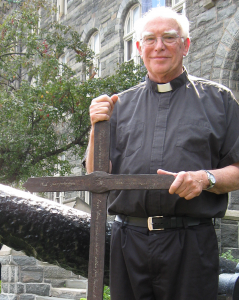
The Dahlgren Chapel cross, which was discovered in a storage space in Healy Hall by Fr. G. Ronald Murphy, S.J. (pictured) in 1989, will be featured at Pope Francis’ first mass next Wednesday.
For more than two decades, churchgoers at Dahlgren Chapel have prayed under an iron cross that accompanied the voyage of the first settlers from England to Maryland in 1634. When Pope Francis conducts his first service at the National Shrine of the Immaculate Conception next Wednesday, the same cross will hang on the altar above him, in view of thousands of worshippers.
Since it was first discovered in the university’s archives in 1989, the 4-foot tall cross has served as an iconic symbol of not only Georgetown’s Jesuit tradition, but also the expansion of the Catholic faith in America.
Fr. G. Ronald Murphy, S.J., who was responsible for the discovery of the cross, said that the use of the cross at the papal mass is significant, particularly because it was used in the first Catholic mass in an English-speaking colony in the Americas.
“The most important artifact that we can lay out for [Pope Francis’] appreciation is this cross,” Murphy said. “The cross is a symbol of both Catholicism and religious liberty at the same time.”
The Archdiocese of Washington first issued a request for the cross to be featured on the altar of the basilica during the organization of the papal mass.
Director of Music, Liturgy and Catholic Life Jim Wickman delivered the cross to the Basilica of the National Shrine of the Immaculate Conception last Thursday in preparation for the pope’s mass.
Wickman said that the cross signifies a connection between Georgetown, the oldest Jesuit university in the country, and Pope Francis, the first Jesuit pope in history.
“In a sense, having the Dahlgren Chapel cross at this mass is having a piece of Georgetown at the mass with the Holy Father, and that is so important to us as the oldest Jesuit and Catholic university in the U.S.,” Wickman wrote in an email to The Hoya.
Wickman also chose three students who regularly attended mass at Dahlgren Chapel, Spencer Crawford (SFS ’16), Caroline Musslewhite (COL ’16) and Francesca Vullo (COL ’16), to accompany him during the delivery. The three students wrapped the cross in a blanket and carried it onto a car that took them to the basilica.
Crawford said that the cross is a symbol of the university’s interreligious values.
“When I see the cross at the mass that Pope Francis will be celebrating, I’ll think of my Hindu friends, my Muslim friends and my Catholic friends at Georgetown, and how Georgetown really fosters interreligious dialogue in our personal, spiritual lives,” Crawford said.
The cross made its journey to America in 1634 onboard the Ark and the Dove, two ships that carried primarily Catholics to Maryland from England, where Catholics were being persecuted at the time.
Murphy also noted that the Ark and the Dove carried many Protestant passengers, making the cross a symbol of tolerance between the two religions.
“The boats were filled with a mixed population of Catholics and Protestants,” Murphy said. “[The cross] stands for the voyagers’ commitment to the Catholic faith despite persecution in England, and also that ‘we will be respectful for other people of other faiths.’”
According to Murphy, it was likely that the cross was made with iron on the voyage. Musslewhite said that the simple construction of the cross relates to Pope Francis’ messages.
“It was a way to use what they had in front of them, even if it was pretty simple, to remind themselves of God’s presence in their lives, of goodness, of love and of sacrifice,” Musslewhite wrote in an email to The Hoya. “This fits exactly with the Pope’s message for greater unity among all people and respect for the dignity of all.”
In addition to the cross, the pilgrims also carried eight cannons, two of which were given to the university and placed outside of Healy Hall in 1888.
When the settlers arrived, the cross was used to mark a building, likely a school attached to a priest house, as Christian. Eventually, the cross was brought to Georgetown, though the identity of its deliverer remains a mystery. The cross sat in storage for years until Murphy rediscovered it.
Murphy recalled that his discovery of the cross began when he was driving from New Jersey to Georgetown in 1989. When he stopped by St. Francis Xavier Church by the Eastern Shore route, he saw a replica of an iron cross, with an inscription indicating that the original cross was at Georgetown.
“I was so shocked. At the time, I was a director at Georgetown and I said, ‘I know nothing about this. I’ve never heard of a cross that came from the original spot,’” Murphy said.
When he returned to Georgetown, Murphy contacted the university archivist and was directed to a storage space in the south tower of Healy Hall.
Murphy said that his discovery of the cross in the room was almost accidental.
“I looked over to the right and there were swords, sabers and more muskets, and I thought, ‘I want to go over there and see that stuff.’ As I was walking over, I almost tripped and fell because on the floor, on a wooden pallet, was an iron cross. I knew right away when I looked at it that this was it,” Murphy said.
Following its rediscovery, the cross was installed in Dahlgren Chapel as part of the university’s bicentennial celebration.
Murphy said that the Pope’s message aligns with Georgetown’s mission.
“The passengers [on the Ark and the Dove] were extremely tolerant and appreciative of each other, and that made its way years later into the prospectus of Georgetown, which says that we’ll gladly admit students of other faiths,” Murphy said.




















